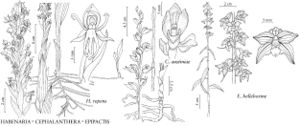Epipactis
Cat. Pl. Hort. Gott., 85. 1757.
| Taxon | Illustrator ⠉ | |
|---|---|---|
 | Habenaria repens Cephalanthera austiniae Epipactis helleborine | Barbara Alongi Barbara Alongi Barbara Alongi |
Herbs perennial, terrestrial, glabrous or puberulent to glabrate. Roots from short rhizome, fibrous. Stems leafy. Leaves several, alternate, sheathing, plicate, grading into floral bracts. Inflorescences terminal racemes; floral bracts leaflike, often exceeding flowers. Flowers few-to-many, resupinate, pedicellate; perianth free, spreading or loosely connivent, subequal; sepals ovate to ovatelanceolate, concave; petals often shorter than sepals; lip sessile at base of column, fleshy, divided into 2 parts by central constriction, proximal part (hypochile) deeply concave to saccate, distal part (epichile) triangular to oblanceolate, with pair of calli near base; column curved over lip, broadened distally, short; anther terminal, sessile; pollinia 4, mealy. Fruits capsules, pendent to spreading, obovoid to ellipsoid.
Distribution
North America, Mexico, Eurasia, North Africa
Discussion
Species ca. 25 (3 in the flora).
Selected References
None.
Lower Taxa
Key
| 1 | Lip 3-lobed, distal part linear-oblanceolate to narrowly spatulate-oblanceolate; lateral sepals 16–24 mm. | Epipactis gigantea |
| 1 | Lip not 3-lobed, distal part triangular-ovate to broadly triangular; lateral sepals 6–13 mm. | > 2 |
| 2 | Lip 9–12 mm, distal part triangular-ovate, calli at base not rugose; ovary glabrous; flowers green to pink to purple to yellowish. | Epipactis helleborine |
| 2 | Lip 5.5–6.5 mm, distal part broadly triangular, calli at base rugose; ovary tomentose; flowers dark wine to cranberry red. | Epipactis atrorubens |